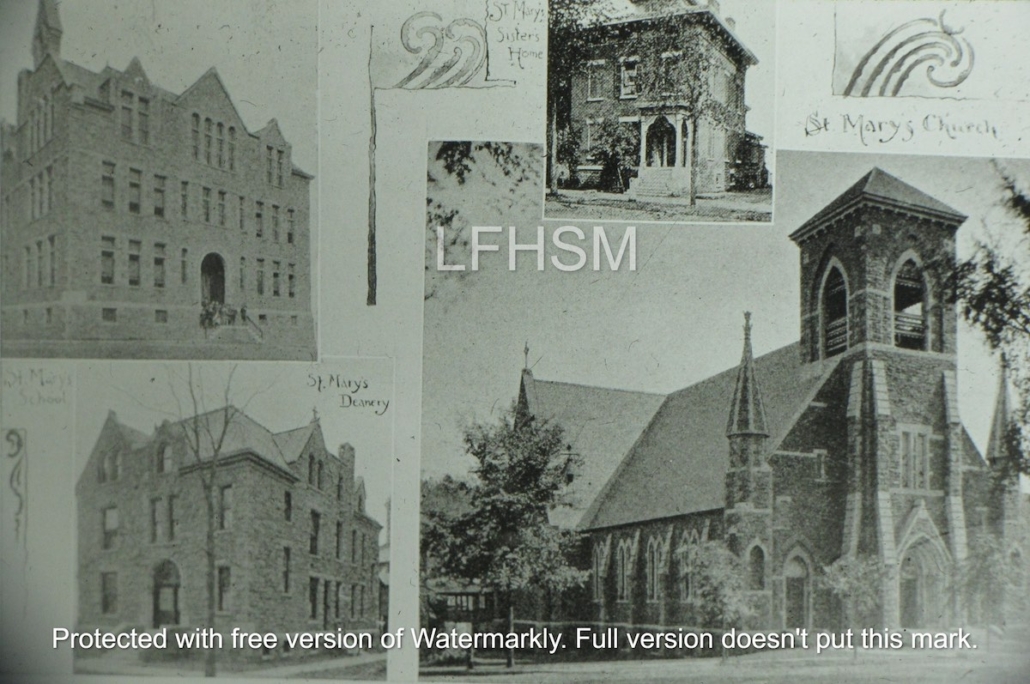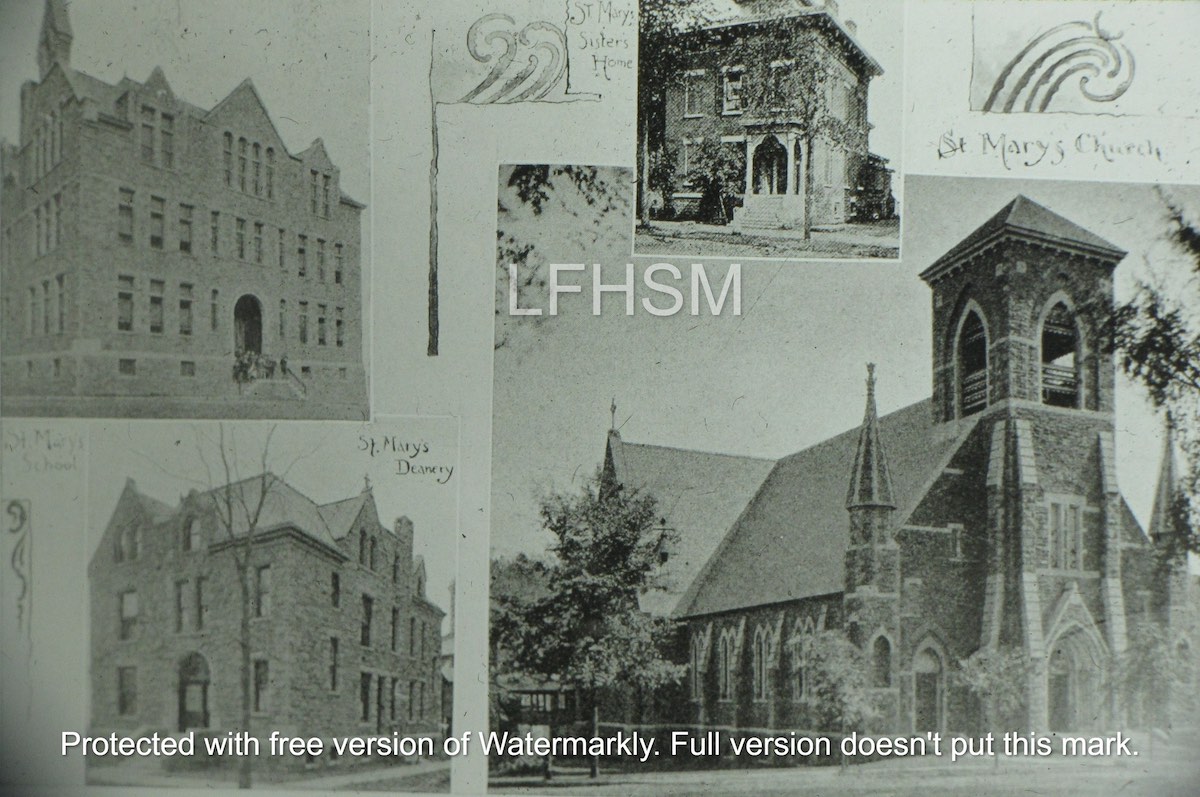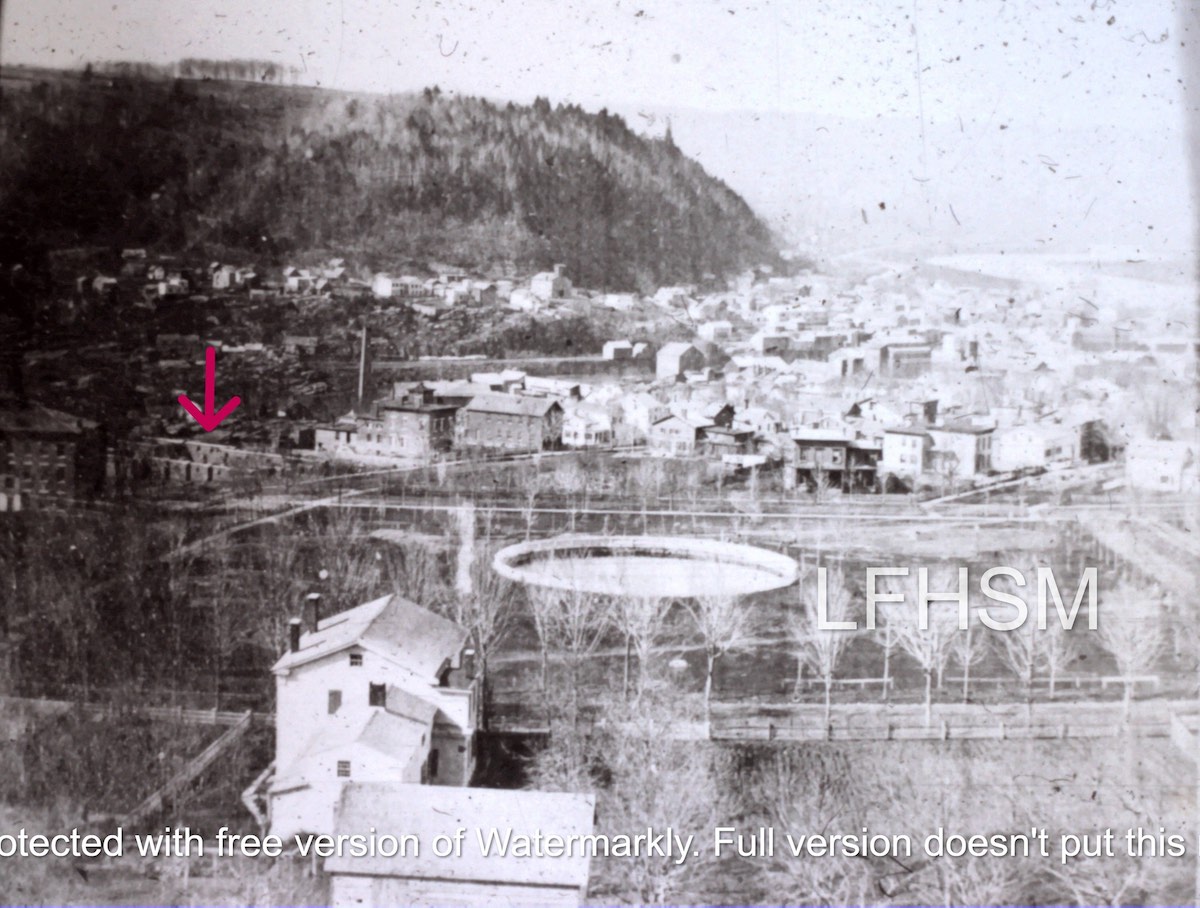June 24, 1881: The recently condemned Catholic church on Petrie Street is being torn down
“ON JUNE 24, 1881, the recently condemned Catholic church on Petrie Street, being the second church built by St. Mary’s, is being torn down by Thomas Dale & Sons for $4,525. The material was then used by the Dale Bros. for the construction of three beautiful brick residences along the corner of Alexander and Petrie Streets on September 24, 1884. The buildings, designed by G. Edward Cooper of Utica, will be fitted with all the modern improvements.”
June 24, 1881, Cooney Archives
The Little Falls Historical Society Museum would like to wish you all a Happy St. Patrick’s Day with highlighting an Irish family, the Dale Family, who has had such a significant impact on the City of Little Falls.
The family’s history at Little Falls began with Samuel Dale’s immigration in 1817 and continues to present-day and beyond with the Samuel S. Dale Memorial Trust, which was established by Samuel’s grandson, Samuel Sherman Dale.
Thomas Dale was born at Carncastle, County Antrim, Ireland, on June 3, 1813.
His father, Samuel Dale, was a farmer, the Dale farm being known as “The Whins”, the house still standing in 1924 in Ireland, a mile and a quarter from the shore and about four hundred feet above the water, giving on a clear day a plain view of Scotland thirty miles across the channel, the change in the color of the land revealing to the Carncastle observer when the Scotch farmer begins to plough the fields in the spring and reap the harvest in the fall.
When Thomas was eighteen months old his mother, who was Agnes Brown before her marriage on May 9, 1804, died on December 24, 1814, leaving her husband with three children: William, aged seven; Robert, aged three, and Thomas, the youngest.
Sixteen months later, on April 27, 1816, Samuel Dale, leaving the three-year-old Thomas in care of a sister, Nancy, sailed with his oldest son William from Belfast for New York, where he landed on June 15, after a passage of forty-nine days.
Early in the following year Samuel Dale, his brother Dan and his son William settled at Little Falls, then a hamlet in a wilderness, with only two streets, forty dwellings and five or six stores, besides a school house, two taverns, grist and saw mills and the unfinished Octagon church, the two brothers being employed as general mechanics. In an old account book there is a record dated March, 1824, of Samuel Dale having “put down 101 clamps in the aqueduct for a Mr. Rogers”. The document found in the gilt ball on the steeple of the Octagon church states that Dan Dale was one of the workmen who completed that famous edifice in 1818.
Thomas attended the Carncastle school, about a third of a mile from his home, passing on his way the churchyard where his mother was buried, and in later years often spoke of his invariable habit of visiting his mother’s grave on his way to and from school.
When he was eighteen years old, he left his home in Ireland to seek his fortunes in the New World, sailing from Belfast on June 16, 1831, and landing in Quebec on August 2 after a passage of forty-seven days. For three years he worked in the woods back of Ottawa, where he was noted for the skill with which he wielded the ax in felling trees.
He left Canada in 1834 to join his father, arriving in Little Falls on Hallowe’en of that year. He went to work at once for Robert Stewart to learn the mason’s trade, his wages consisting of board and clothing, and in addition twenty-five cents per day for the first year, fifty cents for the second, and seventy-five cents per day for the third year. Soon after completing this apprenticeship he formed a partnership with James Sanders, under the name of Sanders & Dale, which continued for several years.
On December 27, 1840, Thomas Dale was married to Fanny Sherman, daughter of Jireh Sherman of Little Falls. Three children were born to Mr. and Mrs. Dale: William H. (1842), George B. (1845), and Samuel S. (1859). William H. and George B. Dale learned the trade of their father, and the three worked together until Thomas Dale’s death on November 3, 1877.
The old account books kept by Thomas Dale show wages and prices of building materials that seem incredible at the present time (1924) when masons earn from $12 to $18 for an 8-hour day. Here are a few items taken at random from the old accounts, the wages being for a day of 10 hours: In 1839: lathing and plastering, $2.00; cutting stone, $2.25; 152 days work on academy and in quarry by Thomas Dale at $2.25; work on the factory, $2.50; common labor in quarry, $1.00; sand, 25 cents a load; lime, 19 and 21 cents a bushel. In 1841; laying stone, $2.00; burning lime, 75 cents and $1.00; pine boards, $20 per thousand feet. In 1842: laying stone, $1.75; work in the quarry by Thomas Dale, $2.00; common labor, 75 cents; brick, $4.62 per M; hemlock boards, $7.50 per M. In 1853: lathing, $2.00; stone mason (Chance Shell), $2.00; mason’s tender (Godfrey Rehm), 88 cents; brick, $5.00 per M. In 1855: mason $1.75 and $2.00; labor in quarry (Geo. Dygert), $1.25; mason’s tender (Godfrey Rehm), $1.50; common labor (Tom Leahy), $1.00; stone mason (Chance Shell), $2.25; work (Wm. H. Dale), $1.00; drill boy in quarry, 25 and 37 1/2 cents; sand, 25 cents a load.
It was on such a low level of wages and values that the buildings at Little Falls were erected by Thomas Dale, his sons William H. and George B., and their workmen, who not only did the actual work of building, but extracted the raw materials from nature’s recesses, quarrying the sandstone and gneiss rock, burning the limestone to obtain lime, and digging the sand from the banks.

St. Mary’s, Holy Family Parish, the “Cathedral of the West” : Located at @763 E. Main Street, Little Falls, NY 13365 | Designed by architect Edward Cooper in the Gothic Style and built by the construction company, Thomas Dale’s Sons in 1879 with locally quarried limestone. The structure seats 1,200 and is 160 x 95 feet, with a present-day height of 185 feet, with the main tower being extended in 1901 and topped with a massive gilded cross.
Only a few of the buildings erected in Little Falls by Thomas Dale and his two sons can be mentioned here, for a complete list would fill many pages of this history.
Thomas Dale worked on the mile-lock on the Erie canal where the highest lock in the world is now located (this when associated with Mr. Sanders); he had charge of blasting the cut at the Gulf curve when the two-track railway was put through Little Falls (associated in this job with Wm. I. Skinner and A. Ward). Among the buildings erected by Thomas Dale are the following: Gilbert’s starch factory; Benton Hall, 1844 part of the old Academy; the George Ashley block (present-day White Rose Bakery), now known as the Burney block, on Main street; the Fox block, still standing as when built, corner Main and Second street; the Wheeler block where the Herkimer County Trust Company’s building now stands; the Cronkhite block ( Cronkhite Opera House); Harry Burrell’s residence, now the home of E. J. Burrell; the Ashley residence (Chapman-Moser Funeral Home Inc); the Harding residence on Gansevoort street; the Universalist church; the Warrior Mower works; the Elboeuf mill, built in 1866 to take the place of the mill destroyed by the flood in 1865; the first building of the Little Falls Knitting Mills ( the Anchor Mill); the Roman Catholic church (St Mary’s Holy Family Parish Church), the foundation of which was the last important work of Thomas Dale, the 1879 church on this foundation being built by Wm. H. and George B. Dale after the death of their father in 1877.
For thirty-two years from the death of Thomas Dale in 1877 to 1909, William H. and George B. carried on the business of mason builders together under the name of Thomas Dale’s Sons. Since the death of George B. in 1909, William H. has continued the business and at the present time has the distinction of having, been engaged continuously in business in Little Falls for sixty-seven years, a longer period than any other resident of the village can boast, the two sons of Thomas Dale having continued the course followed by their father in respect to good work, honest dealing and good citizenship. Among the buildings erected by Wm. H. and George B. Dale are: the Catholic church already mentioned; the Universalist church; the brick mill corner Main and Sixth streets (Titus Sheard Eagle Mills); Rodney Whitman’s residence on Gansevoort street (Elks); Jacob Zoller’s residence on Garden street.
From the day he set foot on United States soil Thomas Dale was a one hundred per cent American, always taking a deep interest in public affairs. To one who once reproached him for being a foreigner, he calmly and proudly replied: “I am an American citizen by choice; you are one by chance. Which condition carries the stronger assurance of loyalty?” He joined the Whig party, was a great admirer of Henry Clay, and an enthusiastic follower of General Harrison in the “Tippecanoe and Tyler too” campaign of 1840. When the Whig party disappeared, he became and ever after remained a republican.
In 1852 Thomas Dale was a member of the committee having charge of building a watchhouse an the north side of Main street. In 1851 he was elected trustee of the village and reelected in 1852, 1862, 1864, 1866 and 1872, his service as trustee comprising a period of ten years. Reared amid the peaceful surroundings of the farming community of Carncastle, Thomas Dale, a youth of eighteen, came to America wholly free from the prejudice and discord that has prevailed in many sections of his native land. Always calm, genial and even-tempered, tolerant of the opinions and beliefs of others, intent on doing justice, ever ready to lend a helping hand to those in distress, upright in all his dealings, industrious, cultivating a pride in doing well all the work that came to his hand, a studious lover of books and learning, Thomas Dale left a record whose influence for good will outlast even the enduring buildings that he erected.
SOURCE: Copied & Pasted from the 1925 book: History of the Mohawk Valley- Gateway to the West 1614-1925 by Nelson Green: Pages 394-396 https://www.schenectadyhistory.org/…/bios/dale_thomas.html
An excerpt from Louis W. Baum’s article “LITTLE FALLS PHILANTHROPY” published in January as part of the Writing Series for the Little Falls Historical Society
Samuel S. Dale
In 1831, Thomas Dale left his home in Ireland for Canada, and in 1834 moved to Little Falls to join his father, who had immigrated to America years earlier. He and his wife, Fanny, a Little Falls native, had three sons William H. (1842), George B. (1845), and Samuel S. (1859). The two oldest sons joined with Thomas to form a construction company around 1858 that built many of the finest homes in the city, as well as several factories along the river and business blocks along Main Street. Thomas died in 1877. William and George continued the business as Thomas Dale’s Sons, and their crowning achievement was the building of St. Mary’s Church which was known as “The Cathedral of the West.” Their uncle, also named William, built the 1833 old bank building, now the home to the Little Falls Historical Society.
Samuel, nearly two decades younger than his brothers, was born in Little Falls in 1859. He embarked on a different career path. At age sixteen, he learned the woolen textile trade at the Mohawk Mill in Little Falls. He moved to New England and spent twenty-five years as an executive in the woolen and worsted mills industry. Samuel Dale became a prominent authority on wool and wrote extensively on that commodity, as well as editing magazines concerning the business. He was a vigorous opponent of the metric system and wrote and lectured nationally against the claim that the adoption of the metric system was necessary for the interest of export trade.
Samuel and his wife were childless; however, his wife devoted herself to aiding children and the elderly in Boston who could not afford medical care. Charlotte Dale died in 1929 and was buried in the Dale family plot in Church Street Cemetery. Samuel died in Brookline, Massachusetts, in August 1940 and was also buried in the family plot in Little Falls.
In October 1947, a copy of his will was received by the Herkimer County Attorney revealing the establishment of a “Dale Memorial Trust” for needy children under the age of 14 and aged who are over the age of 65 and residents of Little Falls, New York. The “Dale Memorial” was to be in memory of his father, mother, and wife, Thomas, Fanny, and Charlotte Dale, “to whose love and devotion I owe all the good that has come to me.” His intent was to continue his wife’s work of assisting children and the elderly in need. In the 1990s, after his last beneficiaries had passed away, the trust was modernized under Massachusetts law, and the “Dale Trust” as we know it began to function.
The Dale Trust has given away approximately $50,000 a year since 1999 to children under 14 and people over 65 who are residents of Little Falls to help pay for medical bills not covered by their health insurance. Also, many non-profit organizations have received grants from the Dale Trust, including Little Falls Hospital, the former Little Falls YMCA, Little Falls Food Pantry, Community Outreach, Little Falls Pop Warner, Little Falls Library, Mohawk Valley Center for the Arts, Little Falls Elementary and Middle Schools, and project Linus, to name a few.
The co-trustee of the “Dale Trust” is the Bank of America, Boston. A female co-trustee of the Dale Trust and her committee, all residents of Little Falls, recommend Dale Trust applications to the Bank of America for disbursement of funds. Dale was quite insistent that besides a corporate co-trustee that there be a female co-trustee of the Dale Trust who is a resident of Little Falls.
Dale would be proud and quite pleased that his trust keeps on giving back to the community on a yearly basis. The Samuel S. Dale papers are a part of the archival collections in the Columbia University Libraries.
To view Louis W. Baum’s Writing Series article “Little Falls Philanthropy” in its entirety , please to go to: https://littlefallshistoricalsociety.org/…/little…/
*From The Cooney Archive’s: This Day In History by Louis Baum JR, Digitizing of historical photos by Gail & Mike Potter, Post compiled & written by Darlene Smith.





